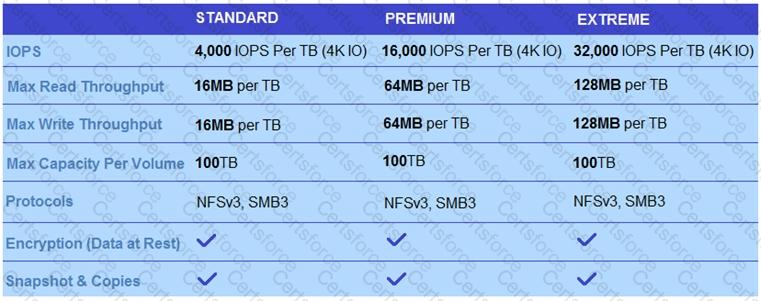Click the Exhibit button.

Your customer has chosen Premium Performance Tier on AWS Cloud Volume Services for a database requiring 15,000 IOPS. However, users are reporting that the database performance is very low.
Referring to the exhibit, what should you recommend?
Which two protocols does a Cloud Volumes Service dual-protocol share support? (Choose two.)
You have an AFF A800 and are tiering data into StorageGRID. You need to keep a second copy of the cold data in an S3 bucket within AWS.
In this scenario, which two NetApp technologies would you use? (Choose two.)
You deploy a pay-as-you-go instance of Cloud Volumes ONTAP. You have an Issue and try to raise a support case with NetApp, but your instance cannot be found.
In this scenario, what caused this problem?
Why would you want to schedule the shut down and restart of Cloud Volumes ONTAP?
You have a cloud-connected storage system that is located in a collocation facility that uses AWS Direct
Connect. The AWS Direct Connect circuit is already configured and you want to verify that your compute
nodes in AWS are able to connect to the volumes created on the storage. You want to verify connectivity using the NFS protocol.
In this scenario, what are three solutions? (Choose three.)
Click the Exhibit button.

You are troubleshooting a failed SnapMirror relationship between two Cloud Volumes ONTAP instances. The source is Azure, and the destination is AWS.
Referring to the exhibit, which connection endpoints need to be verified?
When creating iSCSI LUNs on Cloud Volumes ONTAP, which two statements are true? (Choose two.)
When you export an NFS share to an AWS EC2 instance using OnCommand Cloud Manager, which two steps in the process would it automate? (Choose two.)
You have an NFS export in Cloud Volumes Service, but have an application requirement for block access and SCSI-2 reservations. You need to migrate the data to a new iSCSI LUN presented to a Linux server from Cloud Volumes ONTAP. The Linux server Is also running an NFS server.
In this scenario, which tool would you use to perform this task?